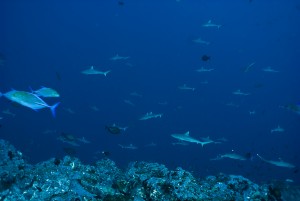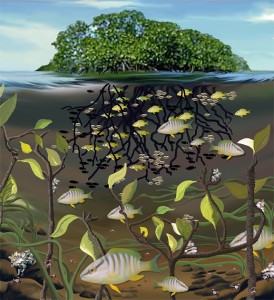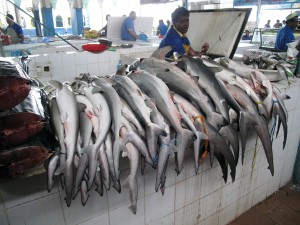
Amazing productivity and biodiversity on remote coral reefs in the central tropical Pacific. (Photo Mark Priest)
Coral reefs are among the most productive and biodiverse ecosystems on Earth. This very fact is famously paradoxical as coral reefs inhabit some of the most oligotrophic environments in the World. My work in coral reefs looks to address this paradox, made famous by Darwin during his early voyages on the HMS Beagle in the 1800s. Theoretical studies suggest that food web structure mediates coral reef functioning through impacts on species diversity, trophic cascades, productivity at higher trophic levels, and biogeochemical fluxes. While a number of studies have highlighted the importance of trophic interactions to reef resiliency, we still lack basic empirical descriptions of food webs on coral reefs and therefore have limited understanding of the important drivers of food web architecture in these systems.
Much of my applied research is focused on understanding food web architecture on coral reefs. In this work I have developed a powerful essential amino acid stable carbon isotope fingerprinting approach within a Bayesian stable isotope mixing model framework to understand carbon flow from distinct baseline end members (water column phytoplankton production, reef derived macroalgal production, reef derived coral production, and microbially reworked detritus) to apex predators. Coral reefs and the goods and services that they provide are under increasing threat from rapid climate change and human activities on both local and global scales. I am particularly interested in how human interaction on coral reefs, such as the removal of key species (e.g., top predators and roaming herbivores) and changes in nutrients at the base of the food web (e.g., coastal eutrophication), alter consumer-resource relationships and ultimate coral reef ecosystem function. Similarly, I am working to develop an mechanistic understanding of how the recent climate change (e.g. the massive 2015 El Nino) effects on productivity, nutrient cycling, and species distribution and abundance, alter food web architecture on coral reefs. Together this work will provide critical knowledge about anthropogenic impacts on coral reef ecosystem function, and provide scientific support to evaluate the effectiveness of management and remediation efforts on restoring ecosystem function.
Phoenix Islands Protected Area

Tremendous biomass of apex predators characterizes the relatively pristine coral reefs of the Phoenix Islands (Photo Mark Priest)
This project involves an interdisciplinary and international partnership among researchers at UCSC, WHOI, KAUST, Université de Perpignan, CRIOBE, and the New England Aquarium. We are currently conducting food web architecture research on reefs from the central tropical Pacific and the Red Sea, which are characterized by natural productivity gradients as well as anthropogenic disturbance gradients. With field work in 2012, 2014, 2015, and 2016, this work will address some fascinating and critically important questions about how individuals, communities, and entire food webs change in response to major climatic events, such as the major El Nino-induced mass coral bleaching event declared in 2015. This research provides critical ecosystem data that can be used to design and implement management policies in PIPA as well as provide ecosystem baseline data for the assessment of impacts and management strategies in more impacted regions.
Primary collaborators: Dr. Simon Thorrold (WHOI); Dr. Michael Berumen (KAUST), Dr. Randi Rotjan (New England Aquarium)
Red Sea
In the Red Sea, I am coupling compound-specific stable isotope analysis (CSIA) with Bayesian modeling to identify major resource dimensions along which consumers on coral reefs partition their ecological niches within complex tropical seascapes. I am particularly interested in understanding how ecologically similar species (e.g., roaming herbivores or meso-predator snapper) coexist despite relying on seemingly shared limited resources. I am also examining how ontogenetic migration connects resource utilization across distinct habitats and distant populations. This work is critical to determine the ecological connectivity of geographically separated populations and the effectiveness of spatial management.
Primary collaborators: Dr. Simon Thorrold (WHOI); Dr. Michael Berumen (KAUST)

Mangroves act as valuable nurseries for many coral reef fishes. Protected among the roots and surrounded by nutrient rich water, juvenile coral reef fishes can mature with ample food and protection until they migrate out to join the adult population on offshore reefs. (Illustration E. Paul OBerlander WHOI)
